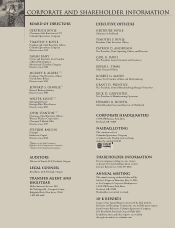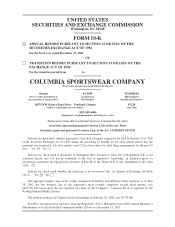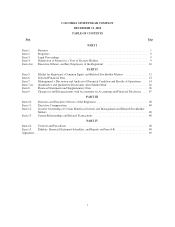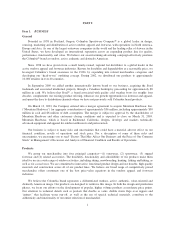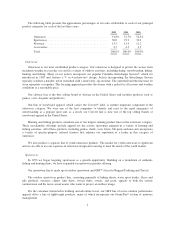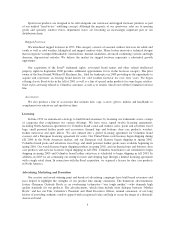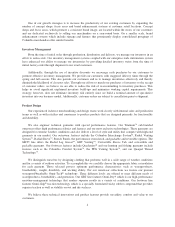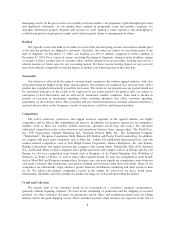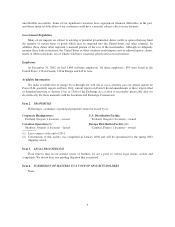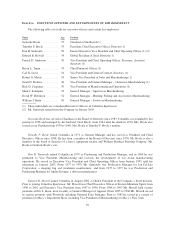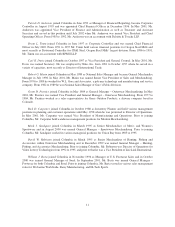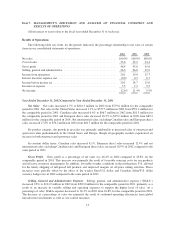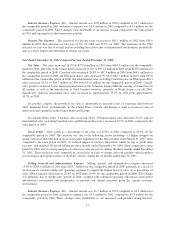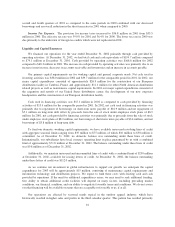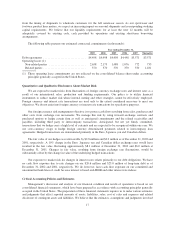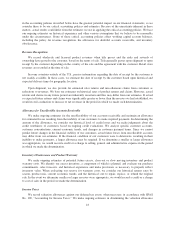Columbia Sportswear 2002 Annual Report Download - page 15
Download and view the complete annual report
Please find page 15 of the 2002 Columbia Sportswear annual report below. You can navigate through the pages in the report by either clicking on the pages listed below, or by using the keyword search tool below to find specific information within the annual report.infringing activity. In the past we have successfully resolved conflicts over proprietary rights through legal action
and negotiated settlements. As our market share expands in geographic scope and product categories, we
anticipate intellectual property disputes will increase as well, making it more expensive and challenging to
establish and protect our proprietary rights and to defend against claims of infringement by others.
Backlog
We typically receive the bulk of our orders for each of the fall and spring seasons at least three months prior
to the date the products are shipped to customers. Generally, the orders are subject to cancellation prior to the
date of shipment. At December 31, 2002, our backlog was $331.5 million, compared to $292.2 million at
December 31, 2001. For a variety of reasons, including the timing of shipments, timing of order deadlines, timing
of receipt of orders, product mix of customer orders and the amount of in-season orders, backlog may not be a
reliable measure of future sales for any succeeding period. For these reasons backlog figures in one year also
may not be directly comparable to backlog figures in another year when measured at the same date.
Seasonality
Our business is affected by the general seasonal trends common to the outdoor apparel industry, with sales
and profits being the highest in the third calendar quarter. Our products are marketed on a seasonal basis, with a
product mix weighted substantially toward the fall season. The results of our operations in any period should not
be considered indicative of the results to be expected for any future period. Our product sales are subject to
substantial cyclical fluctuations and are affected by unseasonal weather conditions. Sales tend to decline in
periods of recession or uncertainty regarding future economic prospects that affect consumer spending,
particularly on discretionary items. This cyclicality and any related fluctuation in consumer demand could have a
material adverse effect on the Company’s results of operations, cash flows and financial position.
Competition
The active outerwear, sportswear and rugged footwear segments of the apparel industry are highly
competitive and we believe this competition will increase. In addition, our licensees operate in very competitive
markets (such as those for watches, leather outerwear, adventure travel bags and socks). We encounter
substantial competition in the active outerwear and sportswear business from, among others, The North Face,
Inc., (VF Corporation), Marmot Mountain Ltd., Woolrich Woolen Mills, Inc., The Timberland Company
(“Timberland”), Patagonia Corporation, Helly-Hansen A/S, Burton and Pacific Trail (London Fog). In addition,
we compete with major sport companies, such as Nike, Inc., Adidas AG and Reebok International Ltd., and with
fashion-oriented competitors, such as Polo Ralph Lauren Corporation, Nautica Enterprises, Inc. and Tommy
Hilfiger Corporation. Our rugged footwear line competes with, among others, Timberland, Nike ACG, Salomon
S.A. and Kamik. Many of these companies have global operations and compete with us in Europe and Asia. In
Europe we also face competition from brands such as Berghaus of the United Kingdom, Jack Wolfskin of
Germany, La Fuma of France, as well as many other regional brands. In Asia our competition is from brands
such as Mont-Bell and Patagonia among others. In many cases, our most significant competition comes from our
own retail customers that manufacture and market clothing and footwear under their own labels. Some of our
competitors are substantially larger and have greater financial, distribution, marketing and other resources than
we do. We believe the primary competitive factors in the market for activewear are price, brand name,
functionality, durability and style and that our product offerings are well positioned within the market.
Credit and Collection
We extend credit to our customers based on an assessment of a customer’s financial circumstances,
generally without requiring collateral. To assist in the scheduling of production and the shipping of seasonal
products, we offer customers discounts for placing pre-season orders and extended payment terms for taking
delivery before the peak shipping season. These extended payment terms increase our exposure to the risk of
8


